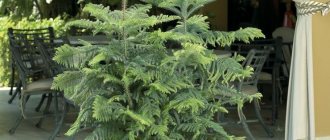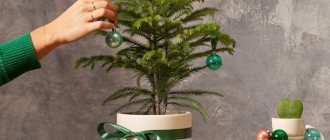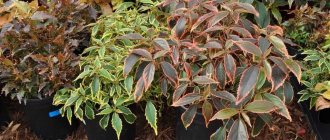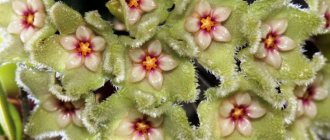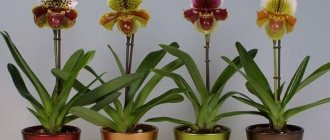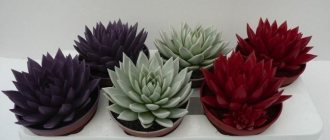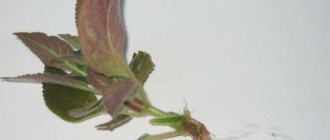Among the rare indoor plants you can see a beautiful Christmas tree, reminiscent of the joyful New Year. But the plant was not bought at the Christmas tree market. Relict Araucaria, grown on our own, decorates our home all year round.
Growing Araucaria in ordinary city apartments is not entirely easy . In order for an unusual “reverse Christmas tree” to please its owners for a long time with its appearance and fill the room with a special aroma, it is necessary to follow the recommended care rules.
And then the branches, directed upward, and not downwards, like those of ordinary Christmas trees, covered with evergreen needles, will be able to recall the distant Jurassic period of the Mesozoic era, when Araucaria reigned in a warm climate . What is this magical tree of antiquity?
Indoor types of araucaria
Araucaria has several indoor species suitable for successful cultivation in an apartment.
| View | Description |
| Brazilian (Narrow-leaved) | The trunk is up to 60 cm, the branches grow straight. The needles are generously distributed among the branches, soft. The crown is quite lush. Cleans the air perfectly. The price is about 1500 rubles. |
| Columnar | A very tall tree, up to 50 m. The leaves are bright green, located on hanging branches, up to 5 cm long. |
| Araucaria Varifolia (Norfolk, Heterophyll) | A very tall tree, up to 70 m. Pyramidal and narrow crown. The branches are very short. |
| Araucaria Chilean | Height up to 60 m, girth about 2 m. The branches are tightly pressed to each other with very hard leaves-needles of a dark green color. The crown is broadly pyramidal. |
| Araucaria Bidwillam (Bunia) | Wide-pyromidal shape and horizontally located branches. The needles are dark green, the cones are quite large. The plant is not a beautiful species, but it is very unpretentious, so it grows successfully in Russia. |
Araucaria is often used in bonsai compositions. The plant takes a long time to form and reduce in size over decades, resulting in a tree 30 cm high.
Araucaria Chilean: description and photo
Arauca pine, “mystery of the monkeys”, Chilean araucaria - all these are the names of one tree, which belongs to the oldest coniferous species. It grew on our planet thousands of years ago and has survived in its natural form to this day only in Australia and South America.
In Europe, they learned about this plant only in 1782 thanks to the efforts of the botanist from Italy H. Molinois. 16 years later (1796) the first tree was planted in England. Here another name appeared - Monkey Puzzle (“monkey riddle”). It is quite widespread and is included in botanical dictionaries. One day, a certain owner of a young araucaria, the trunk and branches of which were completely covered with prickly leaves for a long time, showed it to his guests, Fr.
The first tree in England lived for more than a hundred years. Later, Chilean Araucaria was widespread in Western Europe. In Russia it can only be seen in the botanical gardens of the Caucasus and Crimea. In this article we will tell you more about this exotic plant.
Home care
Araucaria is native to southern countries and hot, very humid climates, but this does not mean that tropical conditions will have to be created indoors. When caring for her at home, you need to take into account that she loves spacious rooms and fresh air.
Araucaria prefers a temperate climate, the light should be diffused and the air should be cool and humid. Very young spruce trees are grown in the apartment; they do not tolerate bright light; in nature they grow in the shade. Indoor species do not bloom, only cones are formed.
| Season/Option | Lighting/Location | Temperature | Humidity |
| Spring | Place in a place with diffused but bright light. Shade on the south side. | Should be cool around +20°C. | High, more than 60%. Regularly spray or pour expanded clay into the pot and constantly moisten it. |
| Summer | Suitable for growing on a loggia. Place in partial shade or a place with diffused light. If possible, take it out into the garden. | Can't stand the heat. Optimal – from +21°C to +25°C. | Spray regularly. |
| Autumn | Partial shade or diffused light. On the north side, regularly turn the plant in different directions so that it does not develop one-sidedly. | Moderate – +20°C. | Keep it high, as dry air is destructive. Spray twice a day. |
| Winter | Bright and diffused light, or partial shade. | Protect from drafts. Not lower than +15°C. | High, frequent spraying required. Place away from the battery. Spray in the morning and evening. |
| Season/Option | Watering | Top dressing |
| Spring | As the soil dries out. If the soil is wet, simply spray the plant with water. | Once every three weeks with special mixtures for coniferous species. |
| Summer | You cannot flood the plant, but it is important to keep the soil moist; you can sprinkle expanded clay on top and constantly moisten it. | Mineral fertilizers once every 3 weeks. |
| Autumn | As the soil dries out. | Need not. |
| Winter | Reduce. |
Choosing a pot, soil, replanting
A large and roomy pot is definitely needed, preferably ceramic. It should have drain holes. Drainage is required to prevent the root system from rotting.
The soil should be fertile and loose, conducting air and nutrients. You can buy a ready-made earthen mixture or make it yourself.
The peculiarity of araucaria is that it does not tolerate transplants. Young Christmas trees grow well in one pot for up to 6 years; adult plants need to be replanted once every 4 years. Planting is carried out at the end of spring.
Step by step procedure:
- Pour drainage and soil into the pot.
- Remove the plant and plant it with a lump of earth in a new pot and sprinkle with soil.
- The roots must not be touched or disturbed, otherwise the spruce will die.
Plant pruning and bonsai formation
Indoor species do not need pruning. In mature spruce trees, you can trim off the bare lower branches. To avoid diseases and infections, the plant must be treated with sulfur.
The formation of bonsai occurs as follows:
- To make an interesting composition in the spring, the crown of the araucaria is adjusted. Cut off excess branches that do not hold the desired shape.
- In May, young shoots of the plant are pinched or pinched to shorten them.
- Using simple wire, the trunk and branches are shaped. It can be left for 3-4 months, then removed.
Reproduction
Araucaria propagation occurs in two ways:
- Seeds. Houses are sown in soil with peat and humus. The earth is watered and placed in a warm place. The first shoots will appear in a few months.
- By cuttings. The top shoots from a large tree are suitable for cuttings. Planted in spring. The cuttings are dried and treated with root. Then they are planted in soil with peat and sand, warming the soil. Each cutting needs its own container, all of them are covered with film. They take root in about 2 months, then they can be transplanted into a permanent pot.
Brief description of cultivation
- Bloom . Araucaria is cultivated as an ornamental foliage plant; in indoor conditions it blooms very rarely.
- Illumination . A tree needs a lot of bright light, which must be diffused.
- Temperature regime . In the warm season - no higher than 20 degrees, and in the winter months - from 10 to 15 degrees.
- Watering . During the growing season, water abundantly, and in the cold season, the substrate is moistened only after it has dried to 2/3 of the depth.
- Air humidity . It should be high, so the tree is often and regularly sprayed with a spray bottle.
- Fertilizer . During the growing season, fertilizers are applied to the substrate once every 15 days. To do this, take a complex mineral fertilizer with a low calcium content.
- Rest period . It begins in late autumn and ends with the onset of spring.
- Transplant . The procedure is carried out in spring or in the first weeks of summer. Young bushes are replanted only after their roots no longer fit into the container, and older bushes - once every 3 or 4 years.
- Soil mixture . Its composition should include peat, sand, leaf and turf soil (1: 2: 1: 2).
- Reproduction . By cuttings and generative (seed) method.
- Harmful insects . Mealybugs and aphids.
- Diseases . The bush can become sick due to improper care or inappropriate conditions.
Araucaria: description, care and reproduction
Errors in care and their elimination
| Errors | Causes | Elimination |
| The shoots are thin. | Few nutrients. | During the period of active growth, feed with fertilizers. |
| The leaves fall, dry out and turn yellow. |
|
|
| The branches withered. |
|
|
| The tree doesn't grow. | Too much fertilizer and calcium in the fertilizer. | Replant the plant in new soil and choose a different fertilizer. |
| The plant died. |
| Avoid these factors. |
| The needles have turned black, the branches are drying up. | The root system is damaged. |
|
Possible problems
If araucaria is not properly cared for, the following problems may arise with it:
- After pruning, the growth of the bush stopped . If the upper part of the araucaria was injured during pruning, then its further development will be incorrect or its growth will stop completely. Provide the plant with a sufficient amount of bright light, make sure that the room is not too cold in winter, and also do not forget that the air humidity should always be high.
- The bush dries and crumbles . If the lighting is too poor and the humidity is low, then the bush's needles begin to fall off, and the stems dry out and turn yellow. If the room is too hot or there is regular stagnation of water in the substrate, then the branches of the plant begin to droop.
- The growth of the bush is very slow . Araucaria grows and develops slowly if the soil mixture contains a lot of calcium.
- Very thin branches . Young branches will be too thin if the plant is fed irregularly.
- Harmful insects . Aphids and mealybugs, as well as pests of coniferous plants, can harm araucaria.
Diseases, pests and methods of combating them
| Pests/Diseases | Fighting methods | Struggle | Prevention |
| Aphid | Punctures from insect bites are visible on the leaves, as they feed on the sap of the Araucaria. | Spray with insecticides: Actellik, Intavir. | You can place Pelargonium nearby, its phytoncides will repel insects, and aphids can be washed off with water. |
| Mealybugs | The flower withers, the branches droop. | Wash off insects with soapy water. | |
| Spider mite | The plant turns yellow and withers, cobwebs are visible on the leaves. | Rinse the plant in the shower, wipe the leaves with soapy water. | |
| Chlorosis | Young shoots lose the richness of the color of the leaves, while adults turn yellow. | Place the araucaria in a place where there are no drafts, increase the temperature in the room and water as soon as the soil dries. Add fertilizer. | Avoid wind and waterlogging of the soil. |
Priming
Araucaria needs a breathable and loose substrate. A nutritious, slightly acidic (pH 5.3 – 6.2) soil is suitable for it. You can make the soil mixture yourself by taking 1 part turf soil, 2 parts perlite, peat soil and leaf soil. You can buy ready-made soil for conifers or a universal substrate for indoor plants and mix it with the substrate for azaleas and rhododendron. Be sure to add crushed pine needles, coal powder, chopped sphagnum, foam balls or brick chips to the soil mixture.
Mr. Summer Resident informs: Araucaria - benefit or harm
The plant has powerful energy. It can awaken creativity and provoke people to be active. Moreover, the effect is both positive and negative. Araucaria enhances the energy in the house, no matter what it is. There is a sign that a plant in the house activates protective properties, gives peace and tranquility to those living in it.
The beneficial property of spruce is that it moisturizes and purifies the air. People with hypertension should not keep it in the house. And for those who have low blood pressure, on the contrary, it is necessary, but it cannot be placed in the rest room.
Araucaria bidwillii
This species is also known as bunia bunia. Belongs to evergreen coniferous plants from the Araucariaceae family. This species is a representative of the Gunia family in a single genus. It is considered one of the most ancient families, which was widespread in the Jurassic period. Fossilized parts of these trees have been found in Europe and America. The height of such a tree is about 50 m, the trunk circumference is 120 cm. The plant is a dicotyledon: female specimens are larger in size than male ones. The shape of a tree's crown changes with its age. Young spruce trees have a wide-pyramidal crown configuration, the side shoots form whorls of 7-12 pieces. They are distinguished by weak branching and drooping ends. Adult specimens shed their lower branches and expose almost half of the trunk. The bark contains a large amount of resinous substances, has a dark brown color and is covered with small horizontal furrows. The leaves have an elongated oval configuration, have a sharp end and a length of 2-7 cm, a leathery structure and a glossy color. They are arranged in a spiral on the upper shoots and in two rows on the side shoots. The leaves that border the apical buds are smaller in size. The leaves are shiny and have clearly defined parallel veins across the entire surface.
The tree is dioecious and produces male and female cones. Female cones form at the ends of side shoots, the leaves on which turn into cone scales. The cones are broadly elliptical or spherical, large in size, which can reach a circumference of 35 cm and a weight of up to 3 kg. In the axils of the cones there are 1-3 grains in each scale. Male trees produce cylindrical cones about 20 cm long and about 1 cm wide. The seeds are 5 cm long and 3 cm wide. This species is widespread in Australia, New South Wales and the Pacific Islands. Due to the heavy cutting down of Araucaria trees, you can see them in nature reserves and protected parks. The name of the species was given in honor of the English traveler George Bidwill, who brought with him several cones and plants to the royal garden of England. From there the plant spread to Europe. The wood of these trees is widely used for making furniture, and the cones are eaten.
Distribution and habitat
Prehistoric distribution of A. angustifolia
in previous geological periods was very different from today. Fossils have been found in northeastern Brazil that show its origins date back to the beginning of the Jurassic period, 200 million years ago, when the American and African continents were connected. Its southward expansion was recent, during the late Pleistocene and early Holocene, possibly as a result of climate change and river-bed migrations.
Until almost the beginning of the 20th century, almost the entire mission region of La Guaira (present-day Brazilian state of Paraná) was covered with araucaria forests, as was much of Santa Catarina, the northern third of the state of Rio Grande do. Sul and an important southern strip of the state of São Paulo. To the west, an important part of the Misiones region also had dense Araucaria forests.
It is currently distributed in the southern and southeastern states of Brazil and in the Argentine provinces of Misiones and Corrientes, although a small population is also present in Paraguay, in the department of Alto Parana, and occurs spontaneously in the Sierra de los Rios, in the north. eastern Uruguay.
Although A. angustifolia
prefers deep, well-drained, slightly acidic soil, it will tolerate almost any soil type as long as the drainage is good. Requires a subtropical climate with heavy rainfall, allowing very high air humidity and periodic frosts. It is a very popular ornamental tree in the subtropics due to the unusual effect of its thick branches with a very symmetrical, reptile-like appearance. It has been artificially introduced to, among other places, southern Bahia, Chile, South Africa, Australia, Kenya, Madagascar, Spain, Portugal and Zimbabwe with variable behavior.
Crown
Externally, the tree differs from the conifers we are used to (spruce, pine). What is the shape of Chilean Araucaria trees? In young plants the crown has a round-conical shape; at an older age it becomes umbrella-shaped. It is formed by long, thick, outstretched branches, slightly sagging at the base, and then ascending branches. The lower branches lie on the ground.
They usually fall off with age. Adult specimens have lateral branches arranged in whorls of 6–7. They are spread horizontally or slightly drooping, which is more often observed in old trees. The crown takes on a flat, umbrella-shaped shape a few years after planting. It is located at the top of the trunk.
Characteristics of domestic spruce
Araucaria is an evergreen plant. In addition to the listed habitats, it is most common in New Caledonia and Norfolk Island.
About 19 species of plants of this genus are counted by specialists. They love open, free areas near bushes and forests.
In uncovered areas, this impressive tree reaches a height of up to 100 meters. The straight large trunk is decorated with vertical branches with leaves of a needle-shaped or leathery surface. In some varieties, the ends of the greens are pointed or resemble an awl. The leaves are arranged in two variants:
- slightly block each other;
- completely cover the lower ones.
Article on the topic: Red spruce description and features
The division into masculine and feminine is not always accurate, since the plant changes its gender during growth. The feminine principle is recognized by spherical bumps with a diameter of 5-30 cm located high on the top of the head. About 200 edible seeds similar to pine nuts are found in the fruit.
The masculine gender presupposes the presence of small cones - no more than 10 cm. The shape of such fruits is cylindrical with a diameter of 5-15 cm.
Trunk
Araucaria Chilean, a photo of which you can see in this article, has a straight, rounded and very slender trunk. It is covered with a thick, resinous, dark brown bark. It clearly shows longitudinal cracks appearing from the bases of discarded, dead branches. The bark is wrinkled and flaking. The annual growth of young plants reaches 45 cm, and then it slows down to 10–15 cm. Trees up to 50 years of age are considered young.
Araucaria wood has a yellowish-white color. It is used in construction. Its resin has found use in folk medicine.
Variety of varieties
Despite the fact that araucaria is also called domestic pine, growing it indoors is quite problematic. The main premises for this tree are called greenhouses and winter gardens. The height and compactness of the spruce depends on the variety of araucaria.
Chilean araucaria (Araucaria araucana)
In 1796, the culture was introduced to England as an ornamental plant. According to history, the first grown tree existed for almost 100 years. Later, araucaria fell in love with Western Europe, and in Russia it became popular in the gardens of the Caucasus and Crimea only recently.
A very massive tree about 60 m in height and a trunk diameter of 1.5 m. Apart from Chile, it is common in western Argentina. It has a pyramid-like crown with a wide base lying almost on the ground. With age, the branches fall off starting from the lower ones. Therefore, the crown of mature plants resembles a flat umbrella at the top of the tree.
Araucaria Chilean with resinous bark is covered with longitudinal cracks. The leaves of the plant are prickly, hard, emerald in color, arranged in a spiral, tightly holding onto the branches.
Clear, light and moist places are the favorite habitat of this tree. In nutritious and fertilized soil it will tolerate drought and cold.
The fruit grains are eaten both fresh and fried. The plant produces seed material only after 30-35 years of life. And light yellow wood is used for buildings.
Columnar (Araucaria columnaris)
It grows in the south of the tropical zone of the New Hebrides and in New Caledonia on the Island of Pine.
The narrow crown, similar to a refined pyramid, is located along the entire length of the large trunk. Usually at the very top of the plant the foliage expands. As with many species, the lower branches fall off with age and the tree takes on an umbrella shape.
The 10 cm long fruits look untidy due to the scales , drawn into a five-millimeter appendage, bent downwards.
The leaves are soft, straight and slightly tapering towards the top. Rich green in color with slightly lightened tips, they look exactly horizontally, or slightly lower the tops.
This type of araucaria has gained popularity in Italy, Africa, Australia and Indonesia. Mostly planting is done in greenhouses.
Indoor (variegated)
Indoor plant for air purification and decoration. At home it stretches up to two meters; in open areas this species can reach 60 m.
The branches, just like other popular varieties, are arranged in the form of a pyramid. The bark is light brown in color and peels off in places. The leaves are small - 2 cm with green needles.
It differs from other varieties in the absence of cones. Therefore, indoor araucaria does not produce seeds. There are several content rules:
- bright room;
- possibility of ventilation;
- distance from direct sunlight;
- air temperature not lower than 12-14 degrees;
- insulation from heat and heat sources;
- good irrigation and humidity;
- in a cool room, water once every two days;
- in apartment conditions, humidify at least three times a day.
When indoor spruce is kept in hot home conditions, its needles begin to turn yellow, which leads to inevitable death.
Araucaria bidwilla and bonsai
An evergreen plant common in southeastern Australia.
Round cones with a soft base fall from the tree before opening. The fruits reach 30 cm in diameter and have nutritious and large nuts or seeds.
The technique of seed germination is interesting. After the open cone falls from the tree, the nut creates a tuber, from which a new trunk emerges in the form of a stem.
Araucaria bonsai, native to South America, prefers bright growing areas with indirect sunlight.
Large trunks about 120 cm in height with needles that grow at an angle of 90 degrees.
Comfortable temperature at home is at least 17 degrees. Constant ventilation will help the plant settle in a new place, but it may die from a draft.
Why do Araucaria branches dry and what to do?
The main sign of improper tree care is the condition of its crown and branches. If they turn yellow and dry, then the plant has been attacked by pests or is sick.
Yellowing of branches
Pests and control methods
Compared to other ornamental greens, araucaria is very rarely attacked by insects that can damage it, but such cases still occur. The tree may be damaged by the following pests:
- Mealybug - a sign of its appearance will be white lumps on tree branches. In order to destroy the pest, you can spray with a solution of alcohol, laundry soap and water, and also treat the tree with special poisons at least three times with an interval of 10 days.
- Root beetle - its appearance is indicated by the dried lower branches of spruce. In order to get rid of the pest, you need to treat the soil with an insecticide solution.
- Aphids appear on the crown of a tree in the form of cone-shaped growths, which grow quite quickly and the plant dries out. Insecticides, for example Mospilan, Calypso, are well suited for getting rid of them.
- The moth leads to the death of the tops of the cuttings, and the plant acquires a brown twig color. It is necessary to treat the tree twice with special products containing pyrethroids, the interval between such measures is 7-8 days.
- Pine loach can be noticed by abnormal curvature of shoots and drying of young branches. It is necessary to remove the affected parts of the spruce and treat it with special chemicals.
When the pest is recognized at an early stage of its development on spruce, the extermination process is much easier, and the appearance of the greenery ultimately quickly returns to normal.
Diseases and treatment
Improper care of the plant can lead to the development of diseases. The following types of diseases are characteristic of araucaria:
- drying and yellowing of the shoots is due to a lack of moisture; you should bathe the flower more often;
- curvature of the trunk indicates improper lighting. You should change the place where the tree grows or turn it over more often;
- slower growth occurs with excess potassium.
- drooping branches indicate excess moisture. The amount of water used when moistening the soil should be reduced;
- thin and sluggish young shoots indicate that the greenery lacks nutrients. You should increase the amount of fertilizing or change the fertilizer to a higher quality one.
Indoor spruce is highly resistant to various diseases of ornamental greenery, but improper care can still harm the plant.
You may be interested in: Chlorophytum curly - home care and propagation Beginning gardeners want to find decorative plants that are useful and easy to care for in everyday life. Excellent…Read more…
Economic and cultural significance
It is the symbol of the Brazilian state of Parana and its capital city of Curitiba, as well as São Carlos in the state of São Paulo and the city of São Pedro in Misiones, Argentina.
Its seeds were important in the diet of indigenous peoples and are still used in many recipes today. Their length ranges from 3 to 7 cm, and their diameter ranges from 1.5 to 2.6. The cones, or female cones, weigh several kilograms and can reach a diameter of about 30 cm, with each cone producing between 20 and 120 seeds.
Dried araucaria branches have high energy value and can be used to produce biomass pellets as biofuel.
Pineapples and seeds (pine nuts). Parana pine gear.
A worm called koro
thrives on fallen trees and is also an excellent food source for local people.
This great tree gave one of the alternative names to the missionary region of Guaira: La Pineria
. On the other hand, the name of the city Curitiba means “forest curis” in the local language.
Possible difficulties when growing araucaria
- The top of the araucaria requires very careful handling - there is a growth point there, if damaged, the plant stops normal growth and development.
- In indoor conditions, the plant usually suffers from dry air, low temperatures in winter, and lack of lighting.
- Excessively warm placement or excess water may cause plant branches to droop.
- If the air is too dry and there is a lack of moisture, the shoots turn yellow and dry out, and the needles may fall off.
- With a lack of nutrition, new shoots grow thin.
- When there is an excess of calcium in the soil, plant growth generally slows down.
- Damaged by: aphids, mealybugs, can be damaged by specific pests of conifers.
